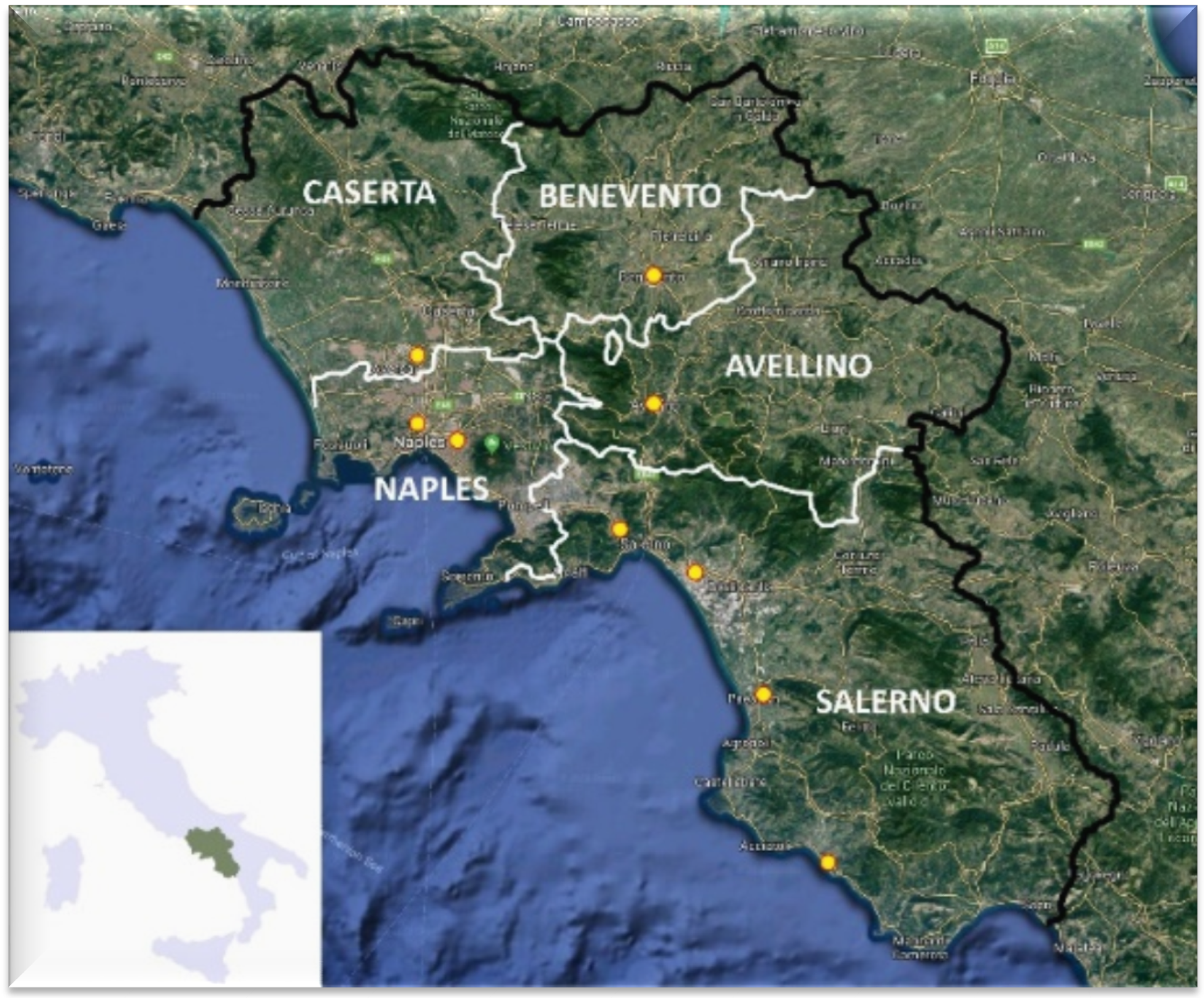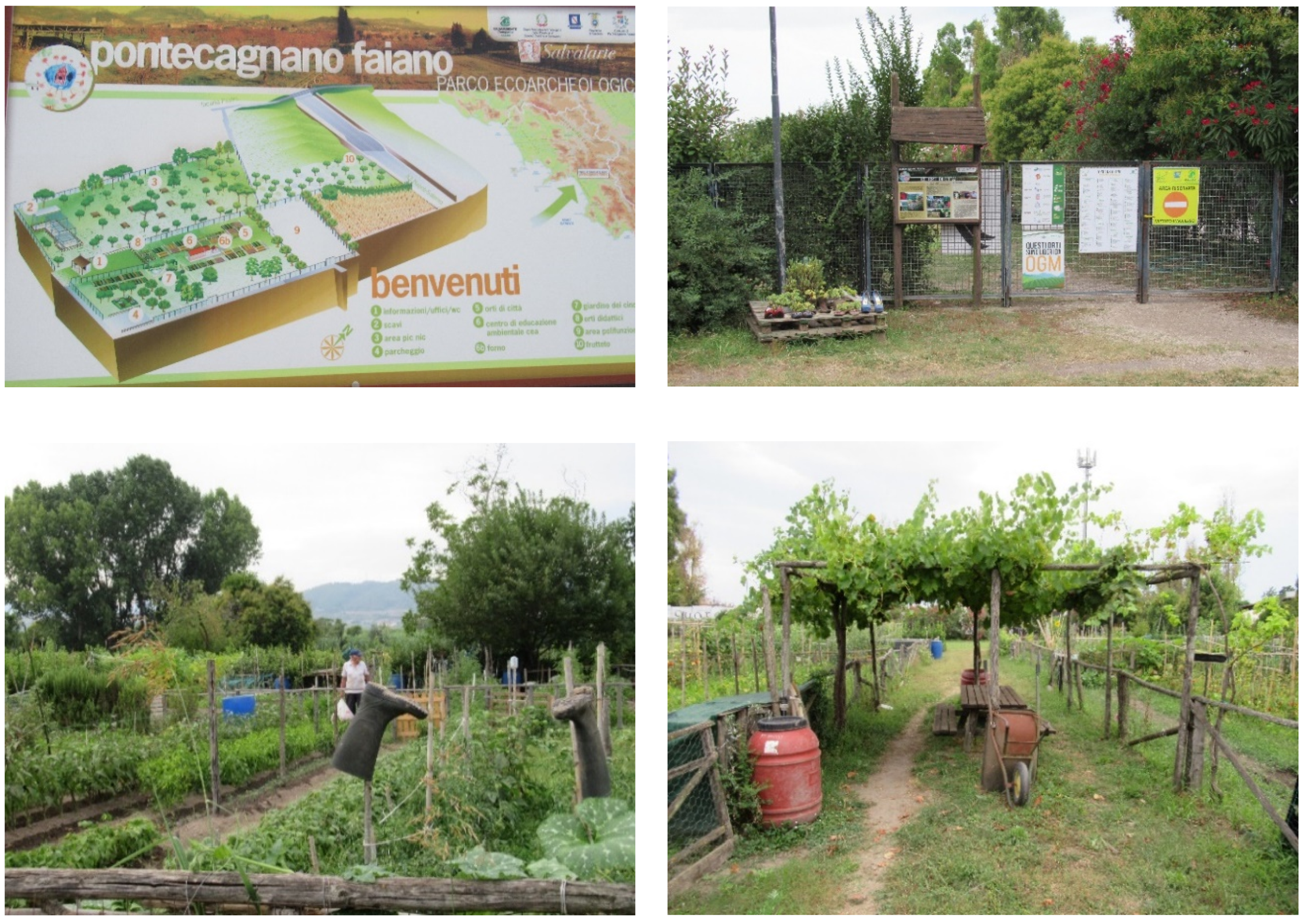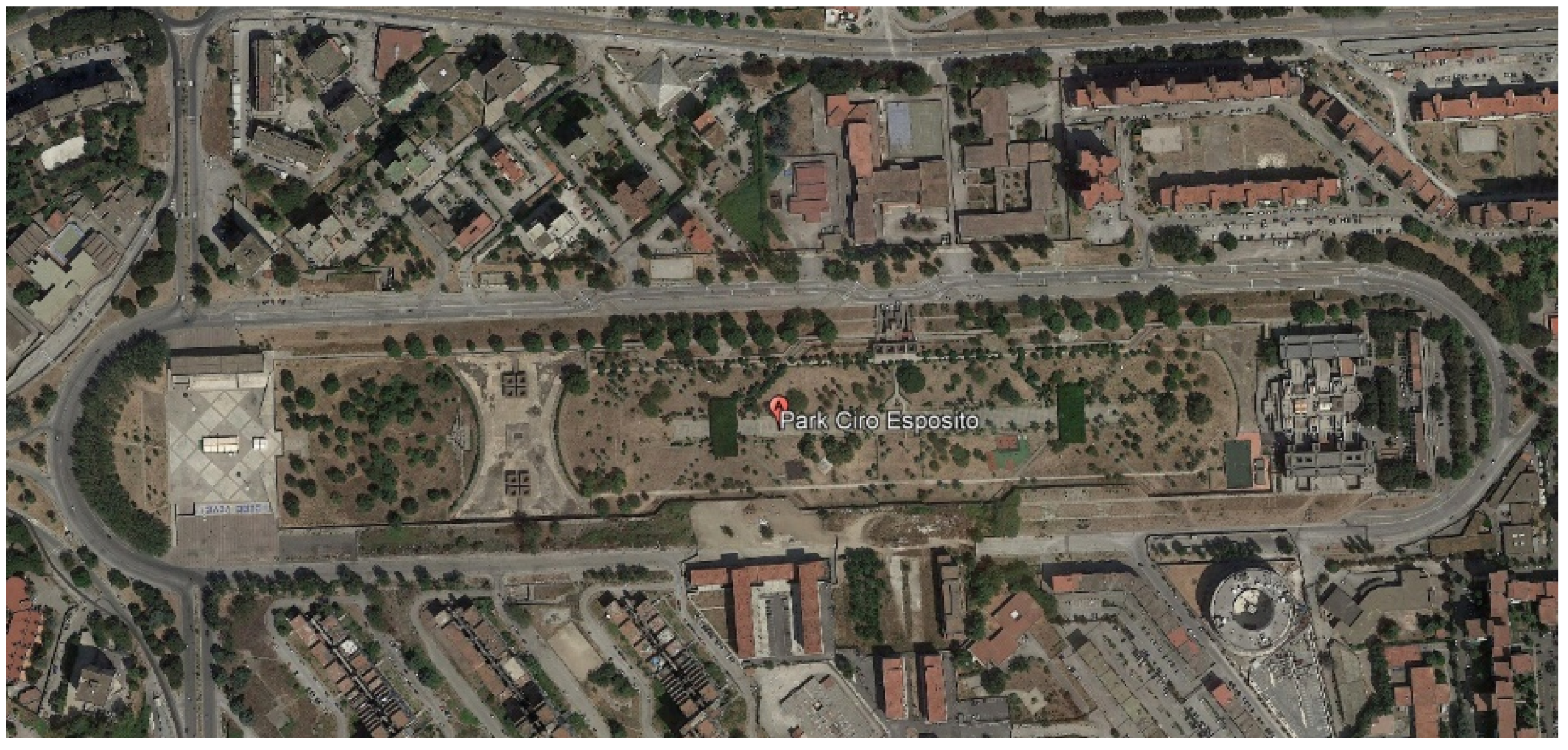Edible Green Infrastructure for Urban Regeneration and Food Security: Case Studies from the Campania Region
Abstract
:1. Introduction
2. Case Studies
2.1. Province of Salerno
2.2. Province of Benevento
2.3. Province of Naples
2.4. Province of Caserta
2.5. Province of Avellino
3. Concluding Remarks
Author Contributions
Funding
Acknowledgments
Conflicts of Interest
References
- Ramaswami, A.; Russell, A.G.; Culligan, P.J.; Sharma, K.R.; Kumar, E. Meta-principles for developing smart, sustainable, and healthy cities. Science 2016, 352, 940–943. [Google Scholar] [CrossRef] [PubMed] [Green Version]
- Ackerman, K.; Conard, M.; Culligan, P.; Plunz, R.; Sutto, M.P.; Whittinghill, L. Sustainable food systems for future cities: The potential of urban agriculture. Econ. Soc. Rev. Irel. 2014, 45, 189–206. [Google Scholar]
- Murthy, V.H. Food insecurity: A public health issue. Public Health Rep. 2016, 131, 655–657. [Google Scholar] [CrossRef] [Green Version]
- Russo, A.; Escobedo, F.J.; Zerbe, S. Quantifying the local-scale ecosystem services provided by urban treed streetscapes in Bolzano, Italy. AIMS Environ. Sci. 2016, 3, 58–76. [Google Scholar] [CrossRef]
- Browder, G.; Ozment, S.; Bescos, I.R.; Gartner, T. Integrating Green and Gray: Creating Next Generation Infrastructure; World Bank and World Resources Institute: Washington, DC, USA, 2019. [Google Scholar]
- Zuniga-Teran, A.A.; Gerlak, A.K.; Mayer, B.; Evans, T.P.; Lansey, K.E. Urban resilience and green infrastructure systems: Towards a multidimensional evaluation. Curr. Opin. Environ. Sustain. 2020, 44, 42–47. [Google Scholar] [CrossRef]
- Wang, Y.; Bakker, F.; de Groot, R.; Wörtche, H. Effect of ecosystem services provided by urban green infrastructure on indoor environment: A literature review. Build. Environ. 2014, 77, 88–100. [Google Scholar] [CrossRef]
- Francis, L.F.M.; Jensen, M.B. Benefits of green roofs: A systematic review of the evidence for three ecosystem services. Urban For. Urban Green. 2017, 28, 167–176. [Google Scholar] [CrossRef]
- Venter, Z.S.; Shackleton, C.M.; Van Staden, F.; Selomane, O.; Masterson, V.A. Green Apartheid: Urban green infrastructure remains unequally distributed across income and race geographies in South Africa. Landsc. Urban Plan. 2020, 203, 103889. [Google Scholar] [CrossRef]
- Russo, A.; Cirella, G.T. Edible green infrastructure for urban regeneration: Case studies from the Campania Region, Italy. In Proceedings of the 4th International Symposium on Infrastructure Development, Hasanuddin University and Manado State Polytechnic, Manado, Indonesia, 12–14 October 2018. [Google Scholar]
- Russo, A.; Escobedo, F.J.; Cirella, G.T.; Zerbe, S. Edible green infrastructure: An approach and review of provisioning ecosystem services and disservices in urban environments. Agric. Ecosyst. Environ. 2017, 242, 53–66. [Google Scholar] [CrossRef]
- Russo, A.; Cirella, G.T. Edible urbanism 5.0. Palgrave Commun. 2019, 5, 1–9. [Google Scholar] [CrossRef]
- McLain, R.J.; Hurley, P.T.; Emery, M.R.; Poe, M.R. Gathering “wild” food in the city: Rethinking the role of foraging in urban ecosystem planning and management. Local Environ. 2014, 19, 220–240. [Google Scholar] [CrossRef] [Green Version]
- Landor-Yamagata, J.; Kowarik, I.; Fischer, L. Urban Foraging in Berlin: People, Plants and Practices within the Metropolitan Green Infrastructure. Sustainability 2018, 10, 1873. [Google Scholar] [CrossRef] [Green Version]
- Shackleton, C.M.; Hurley, P.T.; Dahlberg, A.C.; Emery, M.R.; Nagendra, H. Urban foraging: A ubiquitous human practice overlooked by urban planners, policy, and research. Sustainability 2017, 9, 1884. [Google Scholar] [CrossRef] [Green Version]
- Antisari, L.V.; Orsini, F.; Marchetti, L.; Vianello, G.; Gianquinto, G. Heavy metal accumulation in vegetables grown in urban gardens. Agron. Sustain. Dev. 2015, 35, 1139–1147. [Google Scholar] [CrossRef]
- Entwistle, J.A.; Amaibi, P.M.; Dean, J.R.; Deary, M.E.; Medock, D.; Morton, J.; Rodushkin, I.; Bramwell, L. An apple a day? Assessing gardeners’ lead exposure in urban agriculture sites to improve the derivation of soil assessment criteria. Environ. Int. 2019, 122, 130–141. [Google Scholar] [CrossRef]
- Ferreira, A.J.D.; Guilherme, R.I.M.M.; Ferreira, C.S.S.; de Oliveira, M.d.F.M.L. Urban agriculture, a tool towards more resilient urban communities? Curr. Opin. Environ. Sci. Health 2018, 5, 93–97. [Google Scholar] [CrossRef]
- Shimpo, N.; Wesener, A.; McWilliam, W. How community gardens may contribute to community resilience following an earthquake. Urban For. Urban Green. 2019, 38, 124–132. [Google Scholar] [CrossRef]
- Chandran, R. Grow Your Own: Urban Farming Is Flourishing during the Coronavirus Lockdowns; United Nations: London, UK, 2020. [Google Scholar]
- ICLEI. Nature-Based Solutions for Sustainable Urban Development (ICLEI Briefing Sheet); ICLEI: New York, NY, USA, 2017. [Google Scholar]
- Mancebo, F. Urban Agriculture for Urban Regeneration in the Sustainable City. In Quality of Life in Urban Landscapes; Grifoni, R.C., D’Onofrio, R., Sargolini, M., Eds.; Springer: Cham, Switzerland, 2018; pp. 311–317. [Google Scholar]
- Mancebo, F. Gardening the City: Addressing Sustainability and Adapting to Global Warming through Urban Agriculture. Environments 2018, 5, 38. [Google Scholar] [CrossRef] [Green Version]
- Mancebo, F. Confronting the Dark Side of Urban Agriculture. 2016. Available online: https://www.thenatureofcities.com/2016/04/08/confronting-the-dark-side-of-urban-agriculture/ (accessed on 10 August 2020).
- Colantonio, A.; Dixon, T. Urban Regeneration and Social Sustainability: Best Practice from European Cities; Wiley-Blackwell: London, UK, 2010; ISBN 978-1-405-19419-8. [Google Scholar]
- Czischke, D.; Moloney, C.; Turcu, C. State of the Art on Sustainable Regeneration in Urban Areas, URBACT II Capitalisation; URBACT: Saint-Denis, France, 2014. [Google Scholar]
- Garnett, T. City Harvest: The Feasibility of Growing More Food in London; Sustain: London, UK, 1999. [Google Scholar]
- Sousa, R.; Sales, D. Urban Agriculture: The Allotment Gardens as Structures of Urban Sustainability. In Advances in Landscape Architecture; InTech: London, UK, 2013. [Google Scholar]
- Regional Council of Campania. Regional Law n. 5: Norme in Materia di Agricoltura Sociale e Disciplina delle Fattorie e Degli Orti Sociali e Modifiche alla Legge Regionale 7 Marzo 1996, n. 11; Regional Government of Campania: Naples, Italy, 2012.
- Jansson, J.K.; Hofmockel, K.S. Soil microbiomes and climate change. Nat. Rev. Microbiol. 2020, 18, 35–46. [Google Scholar] [CrossRef]
- Hou, D.; O’Connor, D.; Igalavithana, A.D.; Alessi, D.S.; Luo, J.; Tsang, D.C.W.; Sparks, D.L.; Yamauchi, Y.; Rinklebe, J.; Ok, Y.S. Metal contamination and bioremediation of agricultural soils for food safety and sustainability. Nat. Rev. Earth Environ. 2020, 1, 366–381. [Google Scholar] [CrossRef]
- Cassidy, E.S.; West, P.C.; Gerber, J.S.; Foley, J.A. Redefining agricultural yields: From tonnes to people nourished per hectare. Environ. Res. Lett. 2013, 8, 034015. [Google Scholar] [CrossRef]
- Tóth, G.; Hermann, T.; Da Silva, M.R.; Montanarella, L. Heavy metals in agricultural soils of the European Union with implications for food safety. Environ. Int. 2016, 88, 299–309. [Google Scholar] [CrossRef] [PubMed]
- Mulligan, C.N.; Yong, R.N.; Gibbs, B.F. Remediation technologies for metal-contaminated soils and groundwater: An evaluation. Eng. Geol. 2001, 60, 193–207. [Google Scholar] [CrossRef]
- Hallett, S.; Hoagland, L.; Toner, E. Urban Agriculture: Environmental, Economic, and Social Perspectives. In Horticultural Reviews; John Wiley & Sons, Inc.: Hoboken, NJ, USA, 2016; Volume 44, pp. 65–120. [Google Scholar]
- Włodarczyk-Marciniak, R.; Sikorska, D.; Krauze, K. Residents’ awareness of the role of informal green spaces in a post-industrial city, with a focus on regulating services and urban adaptation potential. Sustain. Cities Soc. 2020, 59, 102236. [Google Scholar] [CrossRef]
- Alon-Mozes, T. Landscape Architecture and Agriculture: Common Seeds and Diverging Sprigs in Israeli Practice. Landsc. J. 2009, 28, 166–180. [Google Scholar] [CrossRef]
- Hoban, P. Agnes Denes’ Prophetic Wheatfield Remains As Relevant As Ever. Available online: https://www.architecturaldigest.com/story/agnes-denes-prophetic-wheatfield-remains-as-relevant-as-ever (accessed on 9 August 2020).
- Jégou, F.; Carey, J. Creating Space for Sustainable Food Systems in Urban Communities: Practical Approaches and Examples for Cities; Strategic Design Scenarios Publishing: Brussels, Belgium, 2015; ISBN 9782960131413. [Google Scholar]
- Rusciano, V.; Civero, G.; Scarpato, D. Urban Gardening as a New Frontier of Wellness: Case Studies from the City of Naples. Int. J. Sustain. Econ. Soc. Cult. Context 2017, 13, 39–49. [Google Scholar] [CrossRef]
- Istat Ambiente Urbano. Available online: https://www.istat.it/it/archivio/225505 (accessed on 2 June 2020).
- Russo, A.; Cirella, G.T. Edible Green Infrastructure 4.0 for Food Security and Well-being: Campania Region, Italy. In International Guidelines on Urban and Territorial Planning. Compendium of Inspiring Practices: Health Edition; Quinlan, V., Ed.; UN Habitat: Nairobi, Kenya, 2018; p. 72, HS/080/18E. [Google Scholar]
- Regional Council of Campania. B.U.R.C. n. 69 of 16/11/2009; Regional Government of Campania: Naples, Italy, 2009.
- Ortoinrete Il Network. Available online: http://www.ortoinrete.it/il-network/ (accessed on 2 June 2020).
- Legambiente Campania. Orti Urbani di Legambiente; Legaambientale: Naples, Italy, 2018. [Google Scholar]
- Organisation for Economic Co-operation and Development. The Italian case studies. COM/TAD/CA/ENV/EPOC(2012)11/FINAL. In Providing Agri-Environmental Public Goods through Collective Action; OECD: Rome, Italy, 2013; pp. 191–203. [Google Scholar]
- Marella, R. Lo spazio urbano come bene comune. Sci. Del Territ. Firenze Univ. Press 2015, 3, 78–87. [Google Scholar] [CrossRef]
- Legambiente. Legambiente Occhi Verdi; Legaambientale: Rome, Italy, 2016. [Google Scholar]
- Fischer, L.K.; Brinkmeyer, D.; Karle, S.J.; Cremer, K.; Huttner, E.; Seebauer, M.; Nowikow, U.; Schütze, B.; Voigt, P.; Völker, S. Biodiverse edible schools: Linking healthy food, school gardens and local urban biodiversity. Urban For. Urban Green. 2019, 40, 35–43. [Google Scholar] [CrossRef]
- TV7. Bosco Lucarelli: Al Via Progetto Sperimentale su Coltivazione Orti Urbani. Available online: https://www.tvsette.net/2018/02/01/bosco-lucarelli-al-via-progetto-sperimentale-su-coltivazione-orti-urbani/ (accessed on 2 June 2020).
- Ortoinrete Gramigna—Orto di Casa Betania—Benevento. Available online: http://www.ortoinrete.it/il-network/gramigna-orto-di-casa-betania/ (accessed on 2 June 2020).
- Ridente, P.; Mezzina, R. From Residential Facilities to Supported Housing: The Personal Health Budget Model as a Form of Coproduction. Int. J. Ment. Health 2016, 45, 59–70. [Google Scholar] [CrossRef]
- Esperienze con il Sud Valorizziamo Scampia. Available online: http://www.napolicittasolidale.it/portal/ncs/primo-piano/5067-valorizziamo-scampia.html (accessed on 14 May 2020).
- Ferrante, M.C.; Fusco, G.; Monnolo, A.; Saggiomo, F.; Guccione, J.; Mercogliano, R.; Clausi, M.T. Food contamination by PCBs and waste disposal crisis: Evidence from goat milk in Campania (Italy). Chemosphere 2017, 186, 396–404. [Google Scholar] [CrossRef]
- Geofilos Orti.net. Available online: www.orti.net (accessed on 2 June 2020).
- Irpinia Solidale. Orti sociali: Al Via le Manifestazioni di Interesse per Partecipare al Nuovo Progetto del CSV. Available online: http://www.orticalab.it/Orti-Sociali-al-via-le (accessed on 14 May 2020).
- Young, C.; Hofmann, M.; Frey, D.; Moretti, M.; Bauer, N. Psychological restoration in urban gardens related to garden type, biodiversity and garden-related stress. Landsc. Urban Plan. 2020, 198, 103777. [Google Scholar] [CrossRef]
- Acton, L. Allotment Gardens: A Reflection of History, Heritage, Community and Self. Pap. Inst. Archaeol. 2011, 21, 46. [Google Scholar] [CrossRef] [Green Version]
- Colinas, J.; Bush, P.; Manaugh, K. The socio-environmental impacts of public urban fruit trees: A Montreal case-study. Urban For. Urban Green. 2019, 45, 126132. [Google Scholar] [CrossRef]
- Bell, S.; Fox-Kämper, R.; Keshavarz, N.; Benson, M.; Caputo, S.; Noori, S.; Voigt, A. Urban Allotment Gardens in Europe; Routledge: New York, NY, USA, 2016; ISBN 9781315686608. [Google Scholar]
- Ville de Paris. Les Parisculteurs project. Available online: http://www.parisculteurs.paris/en/ (accessed on 18 July 2020).
- Wong, K. Paris to Turn a Third of its Green Space into Urban Farms. Available online: https://edition.cnn.com/style/article/urban-farms-in-paris/index.html (accessed on 18 July 2020).
- Van Dijk, M.P. Three Ecological Cities, Examples of Different Approaches in Asia and Europe. In Eco-City Planning; Wong, T.C., Yuen, B., Eds.; Springer: Dordrecht, The Netherlands, 2011; pp. 31–50. ISBN 978-94-007-0383-4. [Google Scholar]
- Chui, E. Doomed Elderly People in a Booming City: Urban Redevelopment and Housing Problems of Elderly People in Hong Kong. Hous. Theory Soc. 2001, 18, 158–166. [Google Scholar] [CrossRef]
- Russo, A.; Cirella, G.T. Urban Sustainability: Integrating Ecology in City Design and Planning. In Sustainable Human–Nature Relations: Environmental Scholarship, Economic Evaluation, Urban Strategies; Cirella, G.T., Ed.; Springer: Singapore, 2020; pp. 187–204. [Google Scholar]
- McLain, R.; Poe, M.; Hurley, P.T.; Lecompte-Mastenbrook, J.; Emery, M.R. Producing edible landscapes in Seattle’s urban forest. Urban For. Urban Green. 2012, 11, 187–194. [Google Scholar] [CrossRef] [Green Version]
- Madaleno, I. Urban agriculture in Belem, Brazil. Cities 2000, 17, 73–77. [Google Scholar] [CrossRef]
- Allum, F. Becoming a camorrista: Criminal culture and life choices in Naples. J. Mod. Ital. Stud. 2010, 6, 324–347. [Google Scholar] [CrossRef]
- Blackburn, K.; Neanidis, K.C.; Rana, M.P. A theory of organized crime, corruption and economic growth. Econ. Theory Bull. 2017, 5, 227–245. [Google Scholar] [CrossRef] [Green Version]
- Mushtaq, R.; Shoib, S.; Shah, T.; Mushtaq, S. Relationship Between Loneliness, Psychiatric Disorders and Physical Health? A Review on the Psychological Aspects of Loneliness. J. Clin. Diagn. Res. 2014, 8. [Google Scholar] [CrossRef]
- Rajkumar, R.P. COVID-19 and mental health: A review of the existing literature. Asian J. Psychiatr. 2020, 52, 102066. [Google Scholar] [CrossRef]
- Russo, A.; Cirella, G.T. Modern Compact Cities: How Much Greenery Do We Need? Int. J. Environ. Res. Public Health 2018, 15, 2180. [Google Scholar] [CrossRef] [PubMed] [Green Version]





| Energy † | Transportation |
|---|---|
| Energy efficiency in buildings Energy demand management and fuel poverty (nonphysical) Energy generation (renewables) District heating and smart grids | Cycling and walking Public transportation and modal shift “Smart travel” and car pooling |
| Land | Water |
| Densification of existing urban areas Urban infill Change of land use in response to local needs | Water conservation Sustainable urban drainage |
| Waste | Food |
| Waste recycling and reduction | Urban agriculture EGI |
| Others | |
| Urban biodiversity and sustainable landscape architecture Use of local construction materials and contractors “Taxation” on consumption (non-physical) Behavioral “nudges” for more pro-environmental behavior (non-physical) | |
| Province | Case Study | EGI Type | Main Benefits and Aims |
|---|---|---|---|
| Salerno | Matti per l’orto | Allotment garden |
|
| Gardens of the Mediterranean diet | Urban farm, domestic garden |
| |
| OrtoMondo | Allotment garden |
| |
| archaeological park | Allotment garden |
| |
| Benevento | “Bosco Lucarelli” Institute | School garden |
|
| Buon orto fa buon sangue | Allotment garden, urban farm |
| |
| Naples | De Filippo park | Urban park |
|
| Ciro Esposito park | Urban park |
| |
| Caserta | Orti.net, coltiviamo la socialit@Caserta | Allotment garden |
|
| Avellino | Irpinia Solidale | Allotment garden |
|
© 2020 by the authors. Licensee MDPI, Basel, Switzerland. This article is an open access article distributed under the terms and conditions of the Creative Commons Attribution (CC BY) license (http://creativecommons.org/licenses/by/4.0/).
Share and Cite
Russo, A.; Cirella, G.T. Edible Green Infrastructure for Urban Regeneration and Food Security: Case Studies from the Campania Region. Agriculture 2020, 10, 358. https://doi.org/10.3390/agriculture10080358
Russo A, Cirella GT. Edible Green Infrastructure for Urban Regeneration and Food Security: Case Studies from the Campania Region. Agriculture. 2020; 10(8):358. https://doi.org/10.3390/agriculture10080358
Chicago/Turabian StyleRusso, Alessio, and Giuseppe T. Cirella. 2020. "Edible Green Infrastructure for Urban Regeneration and Food Security: Case Studies from the Campania Region" Agriculture 10, no. 8: 358. https://doi.org/10.3390/agriculture10080358






